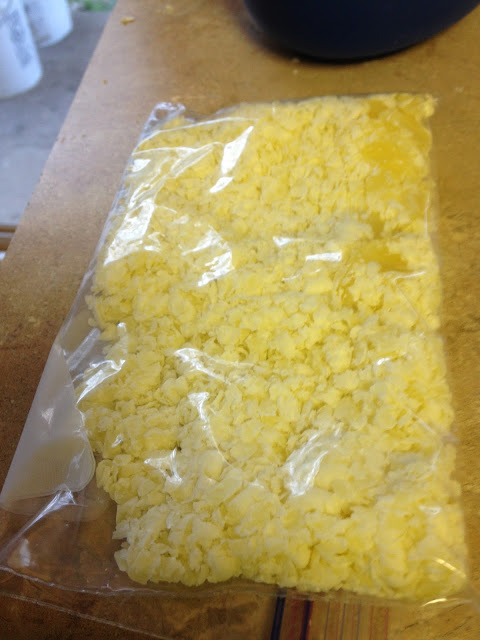Well, since we are "newbees", and we are going to try and overwinter the hive, I thought it might be a good idea to do a mite count. From what I have learned, there are a few key ingredients to overwintering a hive besides a little insulation an prep work on the hive itself. To increase the chances of success for overwintering, a colony should be relatively strong and healthy, that is, have sufficient numbers to overwinter. They should have as low a mite count as possible. And they should have sufficient honey stored up in the brood boxes to eat over the winter.
We also learned that we were supposed to take off the second honey super as well, lest the winter cluster move up into it and damage or kill the queen. So today was also a day to collect the last honey out of the super.
I started out by taking the top cover off of the hive, and finding the inner cover littered with bees!
Inner cover after about ten minutes sitting beside the hive.
This is always a good sign, as it speaks to healthy population.
I removed the frames from the remaining super, brushed the bees off of them near the lower hive opening, and put them in a Rubbermaid tub to bring inside.
Then I took off the super box to look into the hive itself.
iPhone likes to focus on things other than what I want it to...grr...
I was greeted by a large number of bees on the top of the frames. Again, a good sign! I checked a few frames on the top box. LOTS of honey stored in there, it was nice and heavy.
Then I set that box over on the table I had set up, and dug into the middle box. Lots of honey stored in there as well. Then it was time to do my first mite check.
Now, apparently, Varroa mites don't like to cling to bees when the bees are covered in powdered sugar. So awhile back, the U of Nebraska invented a method of checking for mites that went like this...
Get a half cup of bees.
This is much harder than this short sentence makes it out to be. I pulled a frame out of the middle of the box, checked to see if I could see the queen on there, then shook those bees into a shoebox. (I saw all of this on youtube videos, and they made it look a lot easier than it actually is, too.
Then, you are supposedly able to pour those bees into a half cup measure and then into a jar with a mesh top. I'm not sure how it worked so well in the videos, but when I tried to "simply" pour the bees into the measuring cup, the great majority of them took flight and headed back to the hive, or around my head. That first try netted me about a dozen bees. Not enough to do a mite count, since a half cup of bees is 300-400 bees.
So, I gave it another shot with another frame, this one covered top to bottom with bees. I shook the bees into the box and poured a clump of them into the measuring cup, and quickly from there into the jar. By this time, there were roughly five THOUSAND bees buzzing around, wondering what the heck was going on. My heart was racing. Even though I was in my bee suit, this was more bees flying around than usual.
I dumped the powdered sugar in and gently covered all of the bees.
They didn't sound happy, but I figured the sugar was a pretty good peace offering. I also made a mess of the table. But the bees will clean that up, I suspect.
After a few minutes, I shook the jar like a salt shaker (maybe a bit more gently) and shook the mite infested sugar onto a tray. After it was all out, I added some water, and just like in the videos, the mites appeared.
stupid autofocus
Unlike the videos, there were surprisingly few mites in the water. In the videos, they were counting into the tens and twenties. I got five. (The smallest little dots.) There was a bigger black speck of dirt, and a pollen glob (upper left) but that was it! I sent a message to the Bee Squad letting them know my findings, and they responded that our mite count of 1-2 per 100 bees was pretty good! So, they've got a good population of healthy looking bees, lots of honey stored up in the brood boxes. Fingers crossed that they will overwinter well!
Meanwhile, I took the tub of frames inside and started scraping the full frames into the bucket. We don't have a fancy extractor, so we use the old scrape it off and let gravity do its thing method. There was not as many full frames this time, as the bees have been moving honey down into the brood boxes for the winter. But we'll probably get another gallon or so.
Honeycomb on the frame
Scraped frames.
half scraped
scraped into the bucket, well... into the mesh bag in the bucket
Hung over the bucket to drain overnight
After just a few minutes. We'll see how tomorrow goes!




















